660 Private James Wilkins,
2nd Queen’s Royals,
His Book
On the 14th February 1843, at Kilkenny, Co Kilkenny, James Whitely, a shoemaker, enlisted in the 31st Regiment of Foot for a bounty of three pounds, seventeen shillings and sixpence. James was born at Paulstown near Whitehall, Co Kilkenny in September 1823. At the time of enlistment he was described as being 5ft 7in tall, fresh complexion, blue eyes and brown hair.
In 1965 a book was deposited in a rubbish bin for disposal in Sandfield Terrace, Guildford. A curious senior NCO examined it and decided that it could be of some importance. The book deals with Wilkins’ career whilst a soldier and apart from day to day incidents he has written several pages on the restoration of the Third Colour in 1825. For many years the idea was to have the book or extracts of it reprinted, but time and money proved prohibitive. It is very well written and illustrated, sadly, the inks have faded considerably over the years. The copper plate writing is very difficult to read in places because of the fading. Wilkins' book is now in the Surrey History Centre in Woking with other regimental archives, a testament to one of our soldiers period of service in The 2nd or Queen's Royal Regiment from 1823-1846. The Regiment is indebted to Mrs Deborah Boyle for her painstaking work in cleaning, repairing and washing the book. She also kindly made a photocopy of the pages so that the original book will not be damaged. But for the find of "His Book" on a pile of rubbish awaiting disposal, James Wilkins would have been one of the millions of soldiers who have passed into obscurity since the Regular British Army was raised at the Restoration of the Monarchy in 1660. While there could be no doubt about its authenticity, its discovery called for a little research into the seven shelf-miles of old War Office records that survive at the Public Record Office at Kew, as well as in other sources. As a result, we know just a little more about James Wilkins than he chose to tell us in his diary about his service with The Queen's (Second) Royal Regiment of Foot at the Battles of Ghuznee and Khelat-i-Ghilzie during the first Afghan War and in later operations to quell disturbances in south Mahratta country. |
On 12th December 1809 the incumbent of the Parish Church of Warminster, Wiltshire, recorded in his parish register:-
| "James, son of Joseph Wilkins of the Parish of Warminster, and Suzanne his wife, was born on 6th April 1809 and baptised this Day by me." |
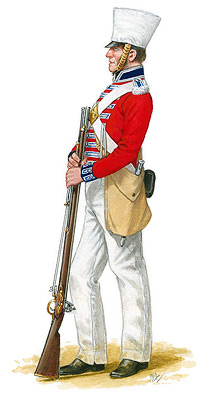 |
| Private, Queen's Royals, arrival in Poona, 1826 |
James Wilkins' birth took place in a disastrous year for the British Army.
Not only had the soldiers of its Peninsular Army been obliged to suffer the appalling privations of the retreat to Corunna, in defence of which the 2nd Foot took part; but thousands of those who survived the evacuation from Spain had died from a form of malaria, as a result of the ill-fated expedition to Walcheren the same year. However, before James had reached the age of five, the British Army had returned to the Peninsular and the 2nd Foot had fought at Salamanca, Vittoria, the Pyrenees, Nivelle and Toulouse, battle honours that were later to be awarded and displayed on its Colours.
Nothing is known of James Wilkins' childhood, save that his father was a schoolmaster, so it is probable that, unlike most of his contemporaries, he learned to read and write at an early age. The social conditions of his time were such that the vast majority of children were born into a miserable life of poverty and want. But James was a trifle more fortunate than most, for he eventually became a humble clerk.
Whether he pursued his apprenticeship in Wiltshire or London must remain in doubt; but the fact points to the Metropolis, as he enlisted there on 29th October 1825 for unlimited service in the 2nd Foot. His original discharge document survives in the collection at Kew to prove the point.
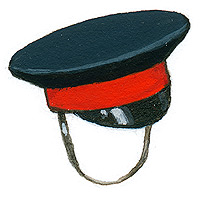 |
| New flat top cap, Officer's pattern |
He was attested at Queen's Square near Soho, an area of London, which, equally with Westminster, was very much favoured by recruiting parties from numerous Regiments. While the 2nd Foot are likely to have had a semi-permanent party, comprising a sergeant, drummer and several privates, beating for recruits in and around London at the time, it would have been accorded with custom for similar parties to be beating in other parts of the country, and perhaps also in Ireland, where the Regiment had been garrisoned in 1823 and 1824.
We can never know whether James Wilkins offered himself for enlistment voluntarily; or whether, having been generously entertained by a crafty old sergeant, he awoke to find the King's shilling in his pocket and to realise that he had "gone for a soldier:' Recruiting was then, as well as before, a remunerative and sought after duty. So, whatever, the circumstances, his recruiters would have been well pleased with their catch.
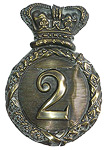 |
| The 1816-29 Shako badge |
The payment of levy money then included a half-crown for each recruit aged 18 or over, and a florin for boys, with the sergeant and drummer taking the lion's share. From James' stated age of seventeen at enlistment and his description at discharge, it is not unreasonable to deduce that he looked considerably younger. Otherwise, he would have been 'advised' to make himself eighteen for very obvious reasons.
Gnarled and wily old recruiting sergeants of the Queen's Royals were no more honest than those of other Regiments, as all had an eye to their 'bringing money'. With a private soldier's pay fixed at one shilling a day, and theirs a little more, hefty deductions from all, who could blame them?
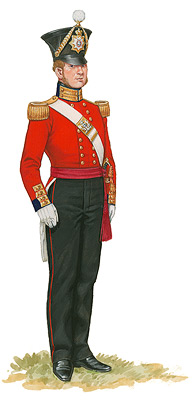 |
| Officer of the Battalion Company |
The quarterly muster returns of the 2nd Foot for 1825, when James Wilkins enlisted, reveal that all ten of its service companies had sailed in divisions from Gravesend for service in India. It had disembarked at Bombay on 7th June after a voyage lasting four months. For the British soldier bound for the East Indies at that time, so long at sea represented the short route! The longer, which fell the lot of many Regiments proceeding to India, and entailed a voyage of six months or more, took many via New South Wales with cargoes of convicts which were disembarked there, before the voyage continued to Bombay or Calcutta. However, the muster returns evidence that, after the departure of the 2nd Foot from England, its depot company, which was responsible for recruiting, training and drafting, had meanwhile remained at Chatham but had rotated to Canterbury during the December quarter of 1825. It was to that place that James Wilkins was marched from London, and the returns evidence that by the end of March in the following year he had joined the Regiment at its encampment at Poona.
It is not the purpose here to reveal the contents of James Wilkins' account in "His Book" of his travels and experiences in India and Afghanistan. Suffice to say, Queen's Royals' musters evidence his presence on duty at Poona until 1830, at Colabah to the north of Bombay until 1834, as well as to the time that a march was made to Poona before the Regiment moved to Belgaum, some 200 miles to the south, in the early part of 1837. Neither is it the purpose to record the operations of the 2nd Foot in Affghanistan (original spelling) and later. For those who seek a deeper knowledge of them, there is a detailed account of the part played by the Regiment in Lieutenant Colonel John Davis' "History of the Second, Queen's Royal Regiment, now The Queen's Royal West Surrey Regiment", which was published in three volumes between 1887 and 1906.
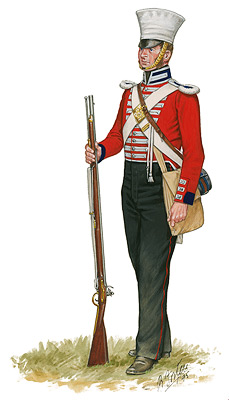 |
The head-dress was the forage cap with a white quilted material cover. This cap was peakless, but the quilted cover formed a false peak. The shell jackets was the same as worn by The 31st except collar, cuffs and shoulder straps were blue. The trousers were a light blue nankeen colour. The equipment was whitened buff leather, bayonet and pouch belt. Belt plate brass, the design a crowned star showing seven points, in the centre the Paschal lamb surrounded by a garter with the motto 'PRISTNAE VIRTUTIS MEMOR', below this the number '2'. On each of the star points the battle honours: top left 'EGYPT' on the right 'VIMERIA', centre left 'CORUNNA' and 'VITTORIA', centre right 'SALAMANCA' and 'PYRENEES', bottom left 'NIVELLE', bottom right 'TOULOUSE', bottom point and below the number '2', 'PENINSULAR'. |
| Private Battalion Company |
|
However, it was in 1837, while the 2nd Foot was at Belgaum, that the greater part of Afghanistan, 1500 miles away to the north, was ruled by Dost Mohammed of Kabul, whose actions had filled the East India Company with alarm. Against the background of the increasing influence of the Russians in Central Asia, there were considerable fears that this treacherous ruler would admit them to India via the great mountain passes that his territory commanded. These fears led to the First Afghan War and caused the 2nd Foot, and James Wilkins and his comrades, together with a mere handful of other Regiments, to be marched northwards in a pitiless climate through the parched, sandy deserts and narrow mountain passes of Baluchistan and Afghanistan, first to Kandahar and then onwards to Kabul.
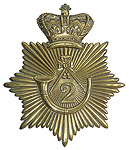 |
| The 1829-44 badge |
The muster returns of The Queen's Royals, each testifying to James Wilkins being on duty, record its presence at Bombay in October 1838, at Bominacole in November, and at Tatta near the mouths of the Indus in December. They reveal its march northwards via Larkhana in the following February, via Soone in March; and its time at Kandahar in April and May. More relevant, while not referring to specific engagements, the locations they yield are absolute proof that James Wilkins fought at the Battles of Ghuznee and Khelat-i-Ghilzie; and they illustrate the remainder of his sojourn in Afghanistan and India until 1845, when, after more than 18 years service on the subcontinent, he was invalided to England.
At Chatham on 10th March 1846, James Wilkins, having been found unfit for further service, was discharged to out-pension of one shilling a day awarded to him by the Commissioners of The Royal Hospital, Chelsea. Leaving aside his non-reckonable, under-age service, his discharge document credits him with total service of 19 years and 134 days; and it states that his character and conduct had been good. Of his medical condition, Surgeon William Harvey of the 2nd Queen’s Royals says in the discharge:-
| “I hereby certify that No. 660 Private James Wilkins, 2nd, or Queen’s Royal Regiment, suffered a great deal from fevers and chest complaints in India, and was injured in the chest by a plank of wood falling on him at the Capture of Ghuznee in July 1839. His general health is very much impaired rendering him quite unfit for the active duties of a soldier. His disability has arisen in the Service and on duty, and has not been brought on or aggravated by any vice or misconduct on his part….” |
James Wilkins’ final description at discharge records his being aged 38 years, 5 feet 5 inches in height with brown hair, brown eyes and a fresh complexion, and a clerk by trade.
Related
